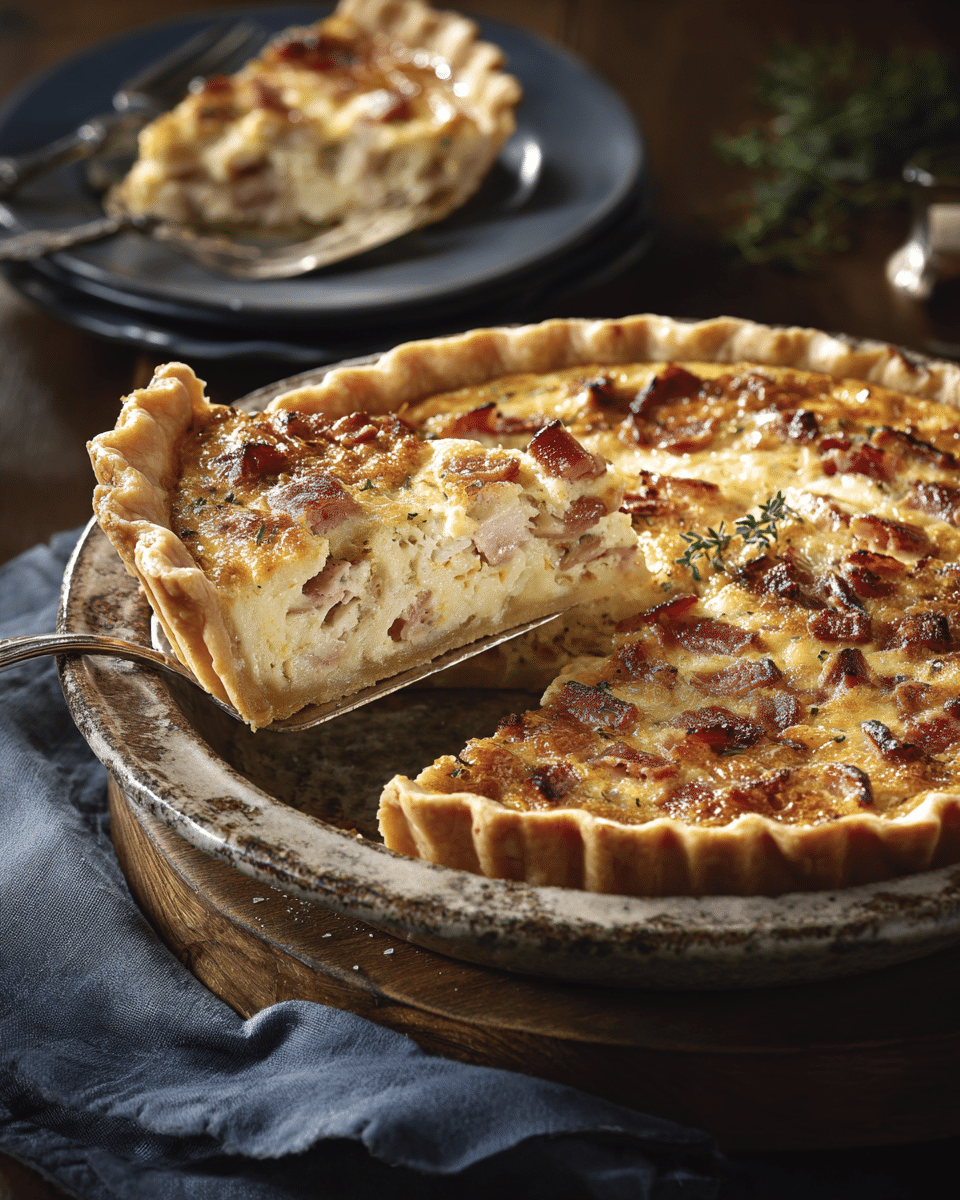Quiche Lorraine is a timeless French dish that combines a flaky pastry crust with a rich, savory custard of eggs, cream, crispy bacon, and melted cheese. Named after the Lorraine region in northeastern France, this elegant yet simple quiche is a favorite for brunches, light lunches, or any meal where a touch of sophistication is desired. With its golden top and creamy interior, Quiche Lorraine delivers classic comfort and gourmet flair in every slice.
FULL RECIPE
Ingredients
- 1 9-inch pie crust (homemade or store-bought, pre-baked)
- 6 slices of thick-cut bacon, chopped
- 1 medium onion, finely chopped
- 1 ½ cups shredded Gruyère cheese (or Swiss cheese)
- 3 large eggs
- 1 ¼ cups heavy cream
- ¼ teaspoon ground nutmeg
- ½ teaspoon salt
- ¼ teaspoon freshly ground black pepper
Directions
- Preheat your oven to 375°F (190°C).
- In a skillet over medium heat, cook the chopped bacon until crisp, about 8–10 minutes. Remove the bacon and drain on paper towels.
- In the same skillet, cook the chopped onion in the bacon fat until softened and lightly golden, about 5 minutes. Remove from heat.
- In a mixing bowl, whisk together the eggs, heavy cream, salt, pepper, and nutmeg until well combined.
- Spread the cooked bacon and onions evenly over the bottom of the pre-baked pie crust.
- Sprinkle the shredded Gruyère cheese on top of the bacon and onions.
- Pour the egg and cream mixture evenly over the fillings in the crust.
- Bake in the preheated oven for 35–40 minutes, or until the quiche is set and the top is lightly golden.
- Let the quiche rest for at least 10 minutes before slicing and serving. Serve warm or at room temperature.
Nutrition Facts
- Calories: 340
- Total Fat: 27g
- Saturated Fat: 13g
- Trans Fat: 0g
- Cholesterol: 140mg
- Sodium: 460mg
- Total Carbohydrates: 10g
- Dietary Fiber: 0.5g
- Sugars: 1g
- Protein: 12g
- Vitamin A: 15% DV
- Vitamin C: 2% DV
- Calcium: 20% DV
- Iron: 6% DV
The Cultural Significance of Quiche Lorraine
Quiche Lorraine is a beloved dish that has become synonymous with French cuisine, despite its relatively humble origins. Hailing from the Lorraine region of northeastern France, the original quiche featured a simple filling of eggs and cream in a bread-dough crust. Over time, bacon and cheese were incorporated, transforming it into the decadent version we know today. Its rise in global popularity began in the 20th century as French cuisine gained prestige worldwide. Today, Quiche Lorraine is a brunch staple, appreciated for its rich flavors and elegant presentation that encapsulate the essence of French culinary tradition.
The Importance of Using a Pre-Baked Crust
One crucial step in making a successful Quiche Lorraine is blind baking the crust before adding the filling. This ensures the crust remains crisp and doesn’t become soggy from the custard. A well-prepared crust provides the foundation for the dish, giving it structure and a pleasant contrast in texture. Whether using a homemade pâte brisée or a store-bought pie shell, baking it until golden helps lock in the integrity of the dish. This technique also enhances the flavor of the crust, contributing a buttery, flaky element that complements the richness of the filling.
Selecting the Right Cheese for Optimal Flavor
Gruyère is the cheese traditionally used in Quiche Lorraine, celebrated for its nutty, slightly sweet flavor and excellent melting qualities. It blends harmoniously with the custard and adds depth without overwhelming the other ingredients. For those seeking alternatives, Swiss cheese or Emmental are acceptable substitutions that still provide a similar creamy texture and mild taste. Choosing a high-quality cheese is essential, as it’s a central flavor in the quiche. Freshly grated cheese also melts more evenly and imparts a better mouthfeel compared to pre-shredded varieties, which often contain anti-caking agents.
The Role of Bacon and Onion in Building Depth
Crispy bacon is a defining ingredient in Quiche Lorraine, adding savory richness and a touch of smokiness that enhances the overall flavor. Rendering the bacon until crisp not only intensifies its taste but also leaves behind fat that can be used to sauté onions, adding another layer of complexity. The onions should be cooked until soft and slightly golden to mellow their sharpness and bring out their natural sweetness. This dynamic duo provides the savory foundation of the dish, contrasting beautifully with the creamy egg custard and the light, flaky crust.
Balancing the Custard for Texture and Structure
The custard in Quiche Lorraine is a delicate balance of eggs and cream, resulting in a smooth, creamy texture when baked to perfection. Heavy cream is the preferred dairy because of its high fat content, which yields a luxurious consistency. Using the right ratio of eggs to cream is key—too many eggs can make the quiche rubbery, while too much cream can leave it overly soft. A well-balanced custard should be silky and just firm enough to slice cleanly, holding together the filling without being overly dense or wet.
Health Benefits and Lighter Alternatives
Though Quiche Lorraine is known for its richness, there are ways to make it lighter without sacrificing flavor. Replacing heavy cream with half-and-half or whole milk can significantly reduce the fat content. Lean turkey bacon or vegetarian substitutes can be used instead of pork bacon for those watching their cholesterol. Additionally, reducing the amount of cheese or using a lower-fat variety helps lower the calorie count. Including vegetables like spinach, zucchini, or mushrooms can also boost the nutritional value while adding fiber, vitamins, and minerals to the dish.
Creative Variations for Every Palate
Quiche Lorraine is easily adaptable to different tastes and dietary needs. For a more Mediterranean twist, sun-dried tomatoes, feta cheese, and olives can be added. For vegetarians, skipping the bacon entirely and incorporating sautéed leeks, spinach, or roasted peppers makes a satisfying alternative. Adding herbs like thyme, chives, or parsley can provide freshness and brighten the flavor profile. The quiche can also be made crustless for a gluten-free option or to cut carbs. With so many possibilities, this dish can evolve to fit a variety of flavor preferences and dietary considerations.
Serving Suggestions and Presentation Tips
Quiche Lorraine is best served warm or at room temperature, making it a convenient choice for brunches, picnics, and buffets. It slices beautifully and can be garnished with a sprinkle of chopped herbs or a small dollop of crème fraîche for a touch of elegance. Pairing it with a light green salad dressed in vinaigrette balances the richness of the quiche. Individual quiche portions can also be baked in muffin tins or tartlet pans for single servings, perfect for parties or meal prepping. Presentation matters, and a golden top with slightly puffed edges signals a perfectly cooked quiche.
Perfect Pairings for a Balanced Meal
Quiche Lorraine pairs well with an array of sides and beverages. For a light lunch or brunch, serve it alongside a crisp arugula or mixed greens salad with a citrus vinaigrette. Roasted asparagus, seasonal fruit, or tomato soup can also complement the dish. When it comes to drinks, a dry white wine such as Sauvignon Blanc or Chardonnay enhances the richness without overpowering it. For non-alcoholic options, sparkling water with lemon, herbal iced tea, or fresh-pressed juice makes a refreshing match. These pairings create a balanced meal that satisfies without feeling too heavy.
Advertisement
Storage, Reheating, and Make-Ahead Tips
Quiche Lorraine stores exceptionally well and is perfect for preparing ahead of time. After baking, allow it to cool completely before covering and refrigerating for up to 4 days. To freeze, wrap individual slices or the entire quiche tightly in plastic wrap and aluminum foil, then store for up to 2 months. To reheat, bake in a preheated oven at 350°F until warmed through, about 15–20 minutes. Microwaving is also an option for convenience but may soften the crust. These storage tips make the dish ideal for meal planning and entertaining without last-minute stress.
Conclusion
Quiche Lorraine remains a timeless favorite in kitchens around the world due to its rich flavors, elegant simplicity, and versatility. With its flaky crust, creamy custard, and savory filling, it strikes a perfect balance between indulgent and refined. Whether served as a main dish for brunch or sliced into small portions for a party appetizer, it delivers satisfaction in every bite. Its adaptability to different ingredients and dietary needs only enhances its appeal. For home cooks seeking a dish that is both classic and customizable, Quiche Lorraine is the ultimate choice.






